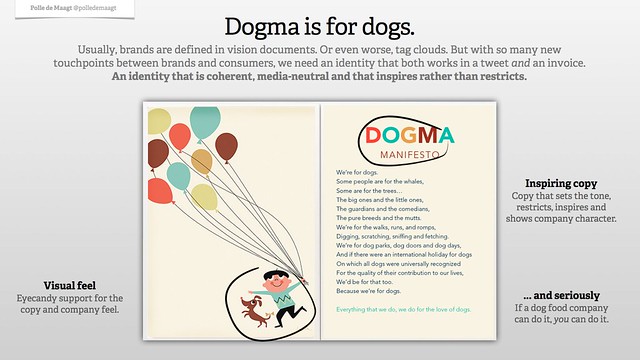A brand definition for a dog food brand. It defines a purpose for the brand, a tone-of-voice, a visual style and gives inspiration and guidance for a plethora of campaigns, products and interactions. Although I genuinely hate dogs (since I got bitten by them several times too much when I was a kid), these 15 lines ignite a spark in me to actually do something for/with this brand. And most brands lack these kinds of inspirational sparks. And they will get punished for that.
Most brands are still defined by inter-changeable vision- or mission statements. By irrelevant insights. Or even worse, tag clouds. Some creative ones have a moodboard. But most of them struggle to manage a consistent or coherent brand experience throughout all interactions with consumers. Because how can you manage the experience throughout employees, tweets, wallposts, invoices, ads and customer service?
And let’s be honest: there are no social brands (yet) and maybe there never will be. Brands that let consumers take control of the brand, that really are customer centric. The majority of all brands are still managed. So let’s focus on these brands.
In earlier days, the solution was pretty simple. It was less difficult to manage customer expectations (read my post on the new hygiene level of customer expectations), the number of contact points (touchpoints) with consumers was pretty limited and it was possible for a corporate communication, brand management or marketing department to maintain a fairly consistent brand experience throughout the touchpoints.
But, while customer expectations were changing, the number of touchpoints were exploding. Not only was it easier for employees to communicate, also the fact that channels like twitter and Facebook enable (and require) realtime communication and gradual engagement make that the number of interactions explode.
It requires a brand to be coherent in both an invoice and a tweet.
It requires a brand to be coherent throughout the different employees.
Failing to be coherent causes problems. How can a brand reply to a tweet in a chatfull manner within the hour, while their call center can’t be reached? How can a brand claim happiness while all their employees look like they hate to work there? How can a brand commit to random acts of kindness when their service is never on time? Well, you get the point.
In order to be able to maintain a coherent brand, it is important to define a very clear and inspiring social brand core and be pragmatic in translating this in different channels. A brand core that guides and limits, but also inspires and ignites sparks. A brand core that gives inspiration to designers and the guys and gals that do the copywriting for tweets. A social brand voice that defines what kind of acts and random acts of kindness are appropriate and which are not.
Coherence doesn’t come from a tag cloud, a mission statement or irrelevant insights. It comes from a social brand voice.
Back to Dogma.
We’re for dogs.
Some people are for the whales,
Some are for the trees…
The big ones and the little ones,
The guardians and the comedians,
The pure breeds and the mutts.
We’re for the walks, runs and romps,
Digging, scratching, sniffing and fetching.
We’re for dog parks, dog doors and dog days,
And if there were an international holiday for dogs
On which all dogs were universally recognized
For the quality of their contribution to our lives,
We’d be for that too.
Because we’re for dogs.Everything that we do, we do for the love of dogs.
You can imagine how this helps employees communicate. How it sparks inspiration to organize events. How it is the inspiration to actually start a international holiday for dogs.
And how it could even lead to a different kind of invoice.
Zappos’ ten core values are another (but imho less inspiring example) and even my former employer Boondoggle had a list of 25 remarkable things about the agency.
We need more brands with social voices like Dogma.

